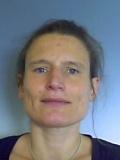Dorothea Pfeiffer

Dorothea Pfeiffer
Dorothea Pfeiffer has engineering degrees in technical computing and electrical engineering, but have been working for years in the field of applied physics. First at GSI/Darmstadt in accelerator operations, then as a CERN fellow as project engineer for the new Gamma Irradiation Facility GIF++ and the LHC forward detectors.
- I joined the ESS detector group in September 2013, and have been responsible for the detector developments for the NMX instrument. NMX requires time resolved neutron detectors with good detection efficiency and excellent spatial resolution. Micro Pattern Gaseous Detectors (MPGDs) have the required properties; therefore, the foreseen detector solution for NMX consists of Gas Electron Multipliers (GEMs) with a Gadolinium neutron converter. The three Gd-GEM detectors will be mounted on robotic arms.
Due to the challenging spatial resolution requirements, the detector R&D for NMX became part of the BrightnESS Work Package 4.2, “The resolution challenge”. Our teams consist of two CERN fellows and me, and we take care of detector simulation and building the detector prototypes. One important part of our work concerns the testing of the VMM2 and the coming VMM3 ASICs as well as testing and integrating all components to have a working detector readout. We are in almost daily contact with the NMX instrument team. For the DAQ we closely collaborate with the team from WP 5.1.
I really appreciate the close collaboration with our WP partners and the team of WP 5.1. Especially since CERN is one of the partner institutes, we hugely profit from developments going in other areas of physics.
The key challenge for me is the limited time of the grant. In this time, we will be able to produce a prototype. Due to the special constraints for NMX, caused by the mounting of the detectors on robotic arms, it is time consuming to develop the optimal detector solution. The integration of the detectors is also a challenge.
I think that neutron scattering detectors will profit from ideas and technical concepts from other fields of physics. This is only possible if one closely listens to the needs of the scientists that will use the instrument. With state of the art technology, it would not be possible to reach the ambitious science goal. However, with BrightnESS, which brings together the best people in their fields, who all work together, it is feasible to win the challenge.

 is funded by the European Union Framework Programme for Research and Innovation Horizon 2020, under grant agreement 676548.
is funded by the European Union Framework Programme for Research and Innovation Horizon 2020, under grant agreement 676548.